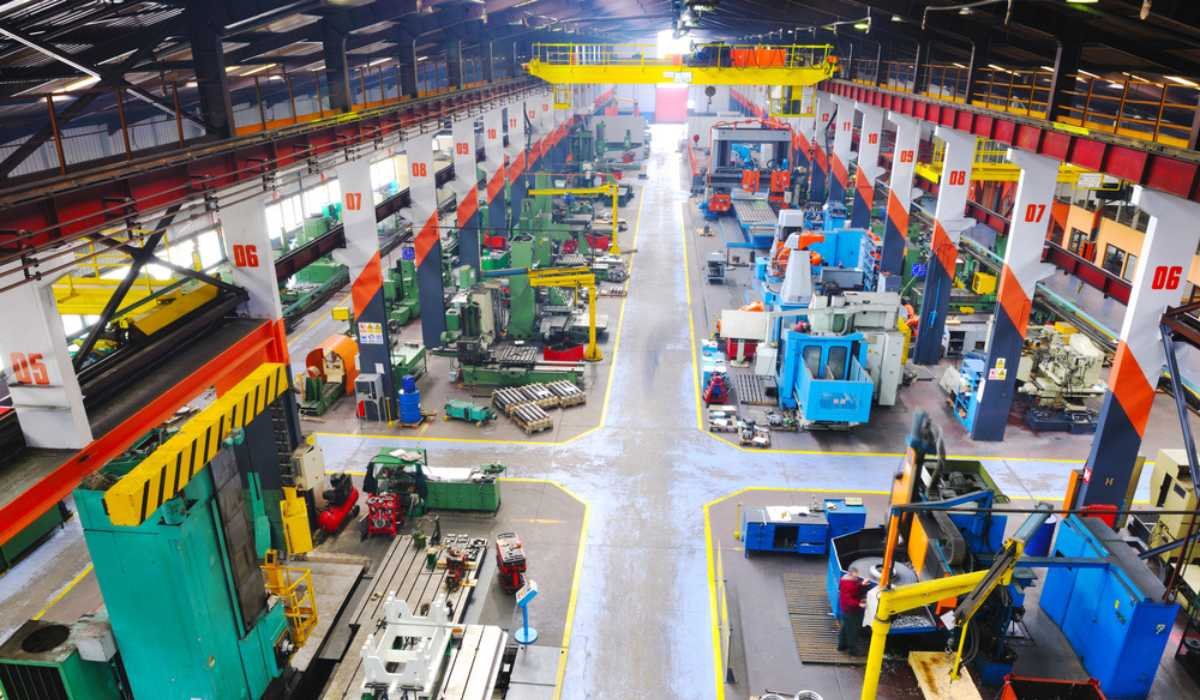The manufacturing sector in India has been witnessing a proliferating growth in investment, depicting a crucial phase in the country’s economic arena, according to a report by Collier India. As per the published dossiers by the Department for Promotion of Industry and Internal Trade (DPIIT), the manufacturing sector engrossed substantial Foreign Direct Investment (FDI), with FDI equity inflows tallying around $17.51 billion in the FY21 itself. This surge emphasises intensified investor confidence and exhibits India’s attractiveness as one of the most lucrative manufacturing destinations in the world, as per Colliers India.
The ‘Make in India’ initiative, a government-led campaign aimed at encouraging domestic manufacturing, has played a pivotal role in accelerating investments. Furthermore, policy reforms and incentives, consisting of the Production Linked Incentive (PLI) scheme, the government has proactively incentivized various manufacturing industries, such as automobiles, electronics and textiles, nurturing an environment conducive to augmented investment.
Swapnil Anil, executive director and head, advisory services at Colliers India, said, “The Indian government is actively fostering a conducive environment for global manufacturing companies through strategic initiatives such as the Bharatmala Pariyojana Project, the proposed DESH Bill, National Logistics Policy, appropriate taxation and incentives for various sectors, thereby enhancing opportunities in the industrial market. Emulating these measures, Indian states offer a myriad of advantages to industrial players, including incentives, subsidies, robust infrastructure and essential utilities. These companies also assess critical factors such as ease of doing business, government policies, economic conditions, pricing, labour availability, regulatory environment, supply chain efficiency, proximity to transport nodes and raw material accessibility when considering entry into the Indian market.”
Propelled by progression in significant sectors and urged by favorable megatrends, India’s manufacturing sector has started itself into new geographies and sub-sectors/segments. Emphasizing the competitive advantage of a skilled workforce and lower cost of labor, the manufacturing sector is also beholding an amplified inflow of capital investment and M&A activity, leading to a surge in manufacturing output and consequential increased contribution to exports.
The manufacturing GVA at current prices was estimated at $110.48 billion in the first quarter of FY 2023-24 (Q1 FY24). The manufacturing sector contributes around 17% to the GDP, supported by robust physical and digital infrastructure which is expected to grow to 21% in the next 6-7 years. India is well-positioned to enhance its manufacturing sector, making considerable advances in global supply chains.
The automotive sector, a keystone of India’s manufacturing prowess, has seen prominent interest from global players like Tesla and Ford, depicting intents for establishing or expanding their manufacturing footprints within the country. Electronics manufacturing experienced a rise in investments, particularly in the smartphone production domain. Major players like Apple’s contract manufacturers established assembly units in India, implying a shift to local production strategies. Additionally, the textiles and garment manufacturing sectors have witnessed upsurge in investment activities, with several global brands reconsidering their sourcing strategies and investing in Indian textile units, taking advantage of India’s competitive advantages in the said domain.
The government of India’s ministry of heavy industries and public enterprises has launched SAMARTH Udyog Bharat 4.0 in 2021 as a strategic initiative intended to enhance the manufacturing sector’s competitiveness, predominantly in the capital goods domain. The government is committed to fostering comprehensive national development by emphasizing the development of industrial corridors and smart cities. These corridors are intended to encourage the adoption of advanced manufacturing practices as well as to facilitate integration, monitoring and the creation of a favorable environment for industrial growth with employment for more than around 27 million workers. With all the policy incentives and various initiatives, the Indian manufacturing market has the potential to reach $1 trillion by 2025-26.
MoUs signed in the manufacturing sector by various states
There have been various memorandums of understanding (MoUs) signed by different states in India to boost the industrial and manufacturing sector. The Maharashtra government has signed 21 MoUs of Rs 88,420 crore at the World Economic Forum in 2023. The MoUs have employment potential of over 55,000 jobs. The MoU conversion rate in Maharashtra is 30- 40%. Andhra Pradesh signed MoUs with 352 firms in Global summit 2023 with proposed investment of Rs 13.5 crore. These projects, if launched successfully, will create 6 lakh jobs within the state. In addition to this, Gujarat has signed 3 MoUs in October 2023 worth Rs 3,000 crore for textile, industrial park, engineering, including auto sector, capable of generating 9,000 new employment opportunities. This is followed by Tamil Nadu, which has signed a total 79 MoUs in the financial year 2022-23 with the total sum of Rs 1.65,748 crore.
Impact of government policies
Various states in India, including Gujarat, Maharashtra, Rajasthan, Madhya Pradesh, Telangana and Andhra Pradesh, have strategically implemented a range of incentives to attract and support manufacturing plants within their borders. In Gujarat, the government offers Common Environmental Infrastructure Facilities at 40% of the project cost up to Rs 50 crore, along with a concessional rate for land use conversion for industrial purposes. Maharashtra extends support by providing manufacturing plants with land at concessional rates and offering a 10-year tax exemption on profits earned from manufacturing activities. Mega and Ultra Mega projects in the state also benefit from the government’s equity partnership of 9% with Financial Closure Institutions exceeding Rs 500 crore.
Rajasthan provides a substantial investment subsidy, covering 75% of the state tax due and deposited for a period of seven years. Meanwhile, in Madhya Pradesh, large-scale industrial units with investments exceeding Rs 10 crore are eligible for a Basic IPA ranging from 40% to 10%. Additionally, financial assistance of up to Rs 1 crore is provided for the development of power, water and road infrastructure, along with support for the establishment or development of industrial parks, including a 15% assistance cap at Rs 5 crore.
Telangana focuses on easing the establishment of manufacturing units by providing doorstep access to essential resources like land, power and water. The government contributes 50% of the infrastructure cost from the Industrial Infrastructure Development Fund (IIDF), with a maximum limit of Rs 1 crore. The state also supports the adoption of cleaner technologies by offering a 25% subsidy, up to Rs 5 lakh, for implementing ‘Cleaner Production Measures.’ Lastly, in Andhra Pradesh, anchor units receive the benefit of required land for their projects at 25% of the land prices, based on the appraisal from the Andhra Pradesh Industrial Infrastructure Corporation (APIIC). These multifaceted incentives showcase the states’ commitment to fostering a conducive environment for manufacturing growth and economic development.
Impact of warehousing and logistic sector
As of 2023, the current size of the industrial warehousing and logistics market is approximately 38.4 million square meter, which includes both Grade A and Non-Grade A developments. According to projections, the market will grow significantly, reaching around 69.7 million square meter by 2026, with Grade A developments accounting for 60% and Non-Grade A developments accounting for the remaining 40%. The Grade-A warehousing sector has experienced consistent growth, owing to the country’s surge in e-commerce, and is expected to maintain a 15% growth rate over the next three years. The overall progress of the industrial market is fueled by the continuous expansion of e-commerce, which is facilitated by advanced technologies and robust networking. In addition, the manufacturing sector has shifted from traditional to cutting-edge technology-based facilities, attracting both domestic and international firms.
The increasing adoption of electric vehicles (EVs) is one of the key drivers of this growth. Consumers and manufacturers are making deliberate decisions to embrace EVs, resulting in rapid growth in the sector. Government policies and incentives are also important in promoting this expansion. Another factor that contributes to growth is infrastructure development initiatives such as the Bharatmala Pariyojana. This programme has proposed 11 industrial corridors with the goal of improving connectivity and logistics networks and, as a result, fostering better trade and commerce. In essence, the dynamic forces of e-commerce, technological advancements, the rise of electric vehicles and strategic infrastructure development initiatives are driving the multifaceted growth of the industrial warehousing and logistics market.
Top regions to invest in India’s manufacturing sector
A detailed study was carried out by Colliers across the states of Gujarat, Maharashtra, Rajasthan, Madhya Pradesh, Karnataka, Andhra Pradesh, Tamil Nadu, Telangana and Odisha focusing on the industrial sector. Gujarat ranked 1st, marginally followed by Maharashtra and then Tamil Nadu. Below are the factors that make them the top-ranking states:
Gujarat
Due to easy labour availability and at a cheaper cost along ith the government supporting policies for the labour force; the state has cheaper land rates for industrial developments. The infrastructure availability in the state, which has such great last mile connectivity and presence of major ports, roadways, railways and also provides water, electricity and renewable energy resources at a cheaper rate compared to other states with very minimal energy dependence. Gujarat also has other financial offers to give to the developers setting up their business within Gujarat. Toyota is set to invest approximately Rs 3,300 crore for a new plant scheduled to be operational by 2026. The Gujarat government has granted a sizable 1.6 lakh square meter of prime land in Sanand, near Ahmedabad, for the establishment of an innovative concentrate manufacturing facility by the renowned Coca-Cola Company
Maharashtra
Due to the best policies, subsidies and incentives offered by the state government. All major and competing businesses have at least a presence in Maharashtra and the state has the highest FDI inflow, industry GDP share, lower unemployment rate, higher number of healthcare and educational facilities, which all combine to make a better general economic scenario of the state. Maharashtra always offers a great deal of support infrastructure in terms of roadways, waterways and railways.
Tamil Nadu
The state has great availability of labor with cheaper rates and favorable labor policies. Tamil Nadu also has good policies, subsidies and incentives for the industrial sector and has a fair presence of support infrastructure with many industrial companies having their footprint in the state.
Emerging manufacturing sectors in India
Exciting emerging themes in India’s manufacturing sector include advanced technologies, sustainable practices, Industry 4.0, local manufacturing focus, AI integration, 3D printing adoption and IoT (internet of things) driven processes. The emerging sector includes semi-conductors, agri tech and waste management, particularly e-waste on which the government has also formulated various policy documents. Key indicators of economic growth include automotive and auto components, cement and capital goods, engineering, chemicals, pharmaceuticals, paper and paper products and the paper and paper products industry.
The Union Budget 2023-24 announced significant measures to boost various sectors of the Indian economy. Startups received additional benefits, such as a tax deduction of up to 100% of profits and an extension of the period for carrying forward losses. The income tax rate for new manufacturing co-operative societies was reduced from 22% to 15%, with a 10% surcharge. By establishing Bio-Input Resource Centres, the government hoped to promote natural farming. M-SIPS, Electronics Manufacturing Clusters and NPE 2019 have all aided in the growth of the electronics system design and manufacturing sector.
| Got any questions or point of view on our article? We would love to hear from you. Write to our Editor-in-Chief Jhumur Ghosh at jhumur.ghosh1@housing.com |

Dhwani is a content management expert with over five years of professional experience. She has authored articles spanning diverse domains, including real estate, finance, business, health, taxation, education and more. Holding a Bachelor’s degree in Journalism and Mass Communication, Dhwani’s interests encompass reading and travelling. She is dedicated to staying updated on the latest real estate advancements in India.
Email: dhwani.meharchandani@housing.com












